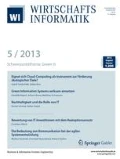Kernpunkte
Für die Realisierung von Softwareproduktfamilien findet das Konzept der Softwareproduktlinie eine zunehmende Verbreitung. Die Softwareproduktlinienansätze integrieren unterschiedliche Wiederverwendungskonzepte und spezifizieren ein Vorgehensmodell, um eine effiziente Produkterstellung zu ermöglichen.
-
Klassische proaktive Vorgehensmodelle zur Entwicklung von Softwareproduktlinien verursachen hohe Initialkosten, die bereits vor der Fertigstellung des ersten Software-Produkts anfallen. Aus diesem Grund sind proaktive Ansätze für kleine und mittelständische Softwareunternehmen (KMU) nur bedingt geeignet.
-
Die automatische Produkterstellung ist eines der Merkmale des höchsten Reifegrades einer Softwareproduktlinie. Durch den Verzicht auf eine sofortige Erfüllung dieses Merkmals kann man die Kosten für die Etablierung und Wartung einer Softwareproduktlinie verringern und damit diesen Entwicklungsansatz auch für KMU anwendbar machen.
-
Beim produktgetriebenen Vorgehen werden die Artefakte der Softwareproduktlinie während der Produktentwicklung realisiert und erst nachträglich in die Softwareproduktlinie integriert.
Abstract
For the realization of software product families the software-technical concept of the software product line finds an increasing spreading. Due to the high initial costs of current methods for software product line development these methods are not suitable for small and medium-size software enterprises. The contribution of this paper is a method for software product line development which reduces costs for the establishment of a software product line, supports a product-driven advancement of product lines and enables the application of the product line approach in small and medium-size software enterprises.
After an introduction to the state of the art, we analyze the requirements for the development of software product lines in small and medium-size enterprises. Subsequently, a product-driven development method is introduced which considers these requirements and supports an evolutionary development of software product lines.
Literatur
Atkinson, Colin; Bayer, Joachim; Bunse, Christian; Kamsties, Erik; Laitenberger, Oliver; Laqua, Roland; Muthig, Dirk; Paech, Barbara; Wüst, Jürgen; Zettel, Jörg: Component-based Product Line Engineering with UML. Addison-Wesley, Boston 2001.
Beck, Kent: Extreme Programming Explained — Embrace Change. Addison-Wesley, Boston 2000.
Bayer, Joachim; Flege, Oliver; Knauber, Peter; Laqua, Roland; Muthig, Dirk; Schmid, Klaus; Widen, Tanya; DeBaud, Jean-Marc: PuLSE: A Methodology to Develop Software Product Lines. In: ACM Fifth Symposium on Software Reusability. ACM Press, 1999.
Bosch, Jan: Design & Use of Software Architectures — Adopting and Evolving a Product-Line Approach. Addison-Wesley, Reading 2000.
Bosch, Jan: Maturity and Evolution in Software Product Lines — Approaches, Artefacts and Organization. In: Chastek, Gary J. (Hrsg.): Proceedings of Software Product Lines, Second International Conference (SPLC), San Diego, CA, USA. Springer, Berlin 2002.
Bosch, Jan: Software Variability Management. Tutorial at 4th Working IEEE/IFIP Conference on Software Architecture. Oslo 2004.
Clements, Paul; Northrop, Linda: Software Product Lines: Practices and Patterns. Addison-Wesley, Boston 2002.
Czarnecki, Krysztof; Eisenecker, Ulrich W.: Generative Programming: Methods, Tools and Applications. Addison-Wesley, Reading 2000.
DeBaud, Jean-Marc; Schmid, Klaus: A Systematic Approach to Derive the Scope of Software Product Lines. In: IEEE Computer Society, Technical Council on Software Engineering; ACM, Special Interest Group on Software Engineering (SIGSOFT): International Conference on Software Engineering. ACM Press, 1999.
Dymond, Kenneth M.: CMM Handbuch — Das Capability Maturity Model für Software. Springer, Berlin 2002.
Faust, D.; Verhoef, C.: Software Product Line Migration and Deployment. In: Software — Practice and Experience, 33 (2003) 5.
Foote, Brian; Opdyke, William F.: Lifecycle and Refactoring Patterns That Support Evolution and Reuse. In: Coplien, James O.; Schmidt, Douglas C. (Hrsg.): Pattern Languages of Program Design. Addison-Wesley, Reading 1995.
Greenfield, Jack; Kozaczynski, Wojtek; Cook, Steve: Software Factories. Wiley, Indiana 2004.
Hofmeister, Christine; Nord, Robert; Soni, Dilip: Applied Software Architecture. Addison-Wesley, Boston 2000.
Kang, Kyo C.; Cohen, Sholom G.; Hess, James A.; Novak, William E.; Peterson, Spencer A.: Feature-Oriented Domain Analysis (FODA): Feasibility Study. Software Engineering Institute (SEI), Carnegie Mellon University, Pittsburgh 1990.
Koch, Sascha; Meister, Jürgen; Rohde, Martin: MUSTANG: A Framework for Statistical Analyses of Multidimensional Data in Public Health. In: Proceedings of the 17th International Conference Informatics for Environmental Protection. Cottbus 2003.
Meister, Jürgen: Produktgetriebene Entwicklung von Software-Produktlinien am Beispiel analytischer Anwendungssoftware. Aschenbeck & Isensee Universitätsverlag, Oldenburg 2006.
Meister, Jürgen; Rohde, Martin; Appelrath, Hans-Jürgen; Kamp, Vera: Data Warehousing im Gesundheitswesen. In: it — Information Technology, 45 (2003) 4, S. 179–185.
Muthig, Dirk: Implementierung von Software-Produktlinien in der Praxis. In: Objektspektrum, 11 (2004) 3, S 66–69.
Riebisch, Matthias; Böllert, Kai; Streitferdt, Detlef; Phillipow, Ilka: Extending Feature Diagrams with UML Multiplicities: In: Proceedings of Integrated Design and Process Technology. Society for Design and Process Science, 2002.
Reussner, Ralf; Hasselbring, Wilhelm (Hrsg.): Handbuch der Software-Architekturen. dpunkt Verlag, Heidelberg 2006.
Riva, Claudio; Del Rosso, Christian: Experiences with Software Product Family Evolution. In: Proceedings of the International Workshop on Principles of Software Evolution. IEEE Computer Society, 2003.
Weiss, David M.; Lai, Chi Tau Robert: Software Product-Line Engineering: A Family-Based Software Development Process. Addison-Wesley, Reading 1999.
Author information
Authors and Affiliations
Corresponding author
Rights and permissions
About this article
Cite this article
Meister, J., Appelrath, HJ. Produktgetriebene Entwicklung von Softwareproduktlinien. Wirtsch. Inform. 49, 180–187 (2007). https://doi.org/10.1007/s11576-007-0048-z
Received:
Accepted:
Published:
Issue Date:
DOI: https://doi.org/10.1007/s11576-007-0048-z
Stichworte
- Softwareproduktfamilie
- Softwareproduktlinie
- produktgetriebenes Vorgehensmodell
- kleine und mittlere Unternehmen (KMU)

